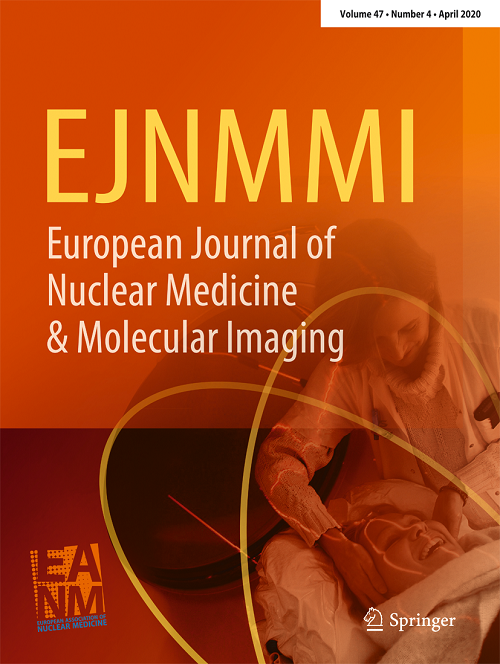使用基于 PSMA-PET 和 PSA 的新型模型,提高对具有临床意义的前列腺癌的诊断准确性,避免对 PI-RADS ≤ 3 MRI 男性进行不必要的活组织检查。
IF 8.6
1区 医学
Q1 RADIOLOGY, NUCLEAR MEDICINE & MEDICAL IMAGING
European Journal of Nuclear Medicine and Molecular Imaging
Pub Date : 2024-10-15
DOI:10.1007/s00259-024-06949-7
引用次数: 0
摘要
简介:对疑似前列腺癌(PCa)但核磁共振成像(PI-RADS≤3)结果不确定的男性进行诊断评估是一项常见的临床挑战。[68Ga]Ga标记的前列腺特异性膜抗原([68Ga]Ga-PSMA)正电子发射断层扫描/计算机断层扫描(PET/CT)在鉴别有临床意义的前列腺癌(csPCa)方面显示出良好的前景。我们旨在建立一个结合 PSMA-PET 的诊断模型,以加强 PI-RADS ≤ 3 男性 csPCa 的诊断过程。所有男性均接受了[68Ga]Ga-PSMA PET/CT 扫描和超声/MRI/PET 融合引导下的活检。对 PSMA-PET 扫描的 PRIMARY 分数进行评估。建立了一个包含 PSMA-PET 和前列腺特异性抗原 (PSA) 衍生参数的诊断模型。该模型的鉴别性能和临床实用性与传统方法进行了比较。结果在这个 PI-RADS ≤ 3 队列中,PRIMARY-score、SUVmax 和常规临床 PSMA-PET 评估检测 csPCa 的曲线下面积(AUC)分别为 0.796(95%CI,0.738-0.853)、0.851(95%CI,0.783-0.918)和 0.806(95%CI,0.742-0.870)。由 PRIMARY-score、SUVmax 和血清游离 PSA/total PSA(fPSA/tPSA)组成的诊断模型的 AUC 为 0.906(95%CI,0.851-0.961),显著高于基于 PRIMARY-score 或 SUVmax 的策略(P < 0.05),明显优于通常基于 PSA 密度的传统策略(P < 0.001)。迭代 1000 次的平均五倍交叉验证 AUC 为 0.878(95%CI,0.820-0.954)。从理论上讲,使用 21.6% 的阈值,该模型可以避免 78% 的不必要活检,同时只漏检了该队列中 7.8% 的 csPCa 病例。与单个传统指标相比,该综合模型可提高诊断准确性,有助于临床决策。它在减少PI-RADS≤3磁共振成像结果男性不必要的活检方面具有巨大潜力,值得进一步进行前瞻性和外部评估。本文章由计算机程序翻译,如有差异,请以英文原文为准。
Using a novel PSMA-PET and PSA-based model to enhance the diagnostic accuracy for clinically significant prostate cancer and avoid unnecessary biopsy in men with PI-RADS ≤ 3 MRI.
INTRODUCTION
The diagnostic evaluation of men with suspected prostate cancer (PCa) yet inconclusive MRI (PI-RADS ≤ 3) presents a common clinical challenge. [68Ga]Ga-labelled prostate-specific membrane antigen ([68Ga]Ga-PSMA) positron emission tomography/computed tomography (PET/CT) has shown promise in identifying clinically significant PCa (csPCa). We aim to establish a diagnostic model incorporating PSMA-PET to enhance the diagnostic process of csPCa in PI-RADS ≤ 3 men.
MATERIALS AND METHODS
This study retrospective included 151 men with clinical suspicion of PCa and PI-RADS ≤ 3 MRI. All men underwent [68Ga]Ga-PSMA PET/CT scans and ultrasound/MRI/PET fusion-guided biopsies. csPCa was defined as Grade Group ≥ 2. PRIMARY-scores from PSMA-PET scans were evaluated. A diagnostic model incorporating PSMA-PET and prostate-specific antigen (PSA)-derived parameters was developed. The discriminative performance and clinical utility were compared with conventional methods. Internal validation was conducted using a fivefold cross-validation with 1000 iterations.
RESULTS
In this PI-RADS ≤ 3 cohort, areas-under-the-curve (AUCs) for detecting csPCa were 0.796 (95%CI, 0.738-0.853), 0.851 (95%CI, 0.783-0.918) and 0.806 (95%CI, 0.742-0.870) for PRIMARY-score, SUVmax and routine clinical PSMA-PET assessment, respectively. The diagnostic model comprising PRIMARY-score, SUVmax and serum free PSA/total PSA (fPSA/tPSA) achieved a significantly higher AUC of 0.906 (95%CI, 0.851-0.961) compared to strategies based on PRIMARY-score or SUVmax (P < 0.05) and markedly superior to conventional strategies typically based on PSA density (P < 0.001). The average fivefold cross-validated AUC with 1000 iterations was 0.878 (95%CI, 0.820-0.954). Theoretically, using a threshold of 21.6%, the model could have prevented 78% of unnecessary biopsies while missing only 7.8% of csPCa cases in this cohort.
CONCLUSIONS
A novel diagnostic model incorporating PSMA-PET derived metrics-PRIMARY-score and SUVmax-along with serum fPSA/tPSA, has been developed and validated. The integrated model may assist clinical decision-making with enhanced diagnostic accuracy over the individual conventional metrics. It has great potential to reduce unnecessary biopsies for men with PI-RADS ≤ 3 MRI results and warrants further prospective and external evaluations.
求助全文
通过发布文献求助,成功后即可免费获取论文全文。
去求助
来源期刊
CiteScore
15.60
自引率
9.90%
发文量
392
审稿时长
3 months
期刊介绍:
The European Journal of Nuclear Medicine and Molecular Imaging serves as a platform for the exchange of clinical and scientific information within nuclear medicine and related professions. It welcomes international submissions from professionals involved in the functional, metabolic, and molecular investigation of diseases. The journal's coverage spans physics, dosimetry, radiation biology, radiochemistry, and pharmacy, providing high-quality peer review by experts in the field. Known for highly cited and downloaded articles, it ensures global visibility for research work and is part of the EJNMMI journal family.

 求助内容:
求助内容: 应助结果提醒方式:
应助结果提醒方式:


